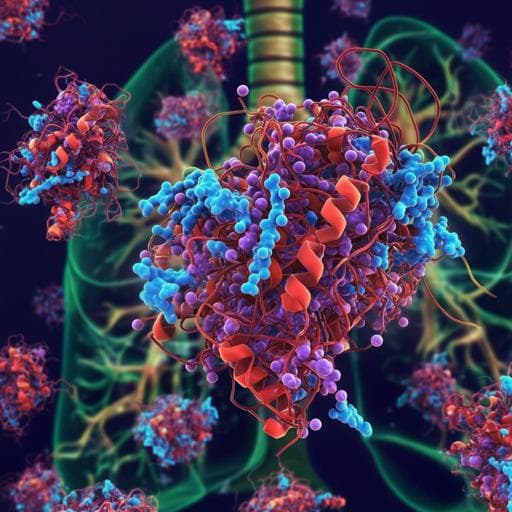
Medicine and Health
Proteomic biomarkers of long-term lung function decline in textile workers: a 35-year longitudinal study
M. Zhao, L. Wei, et al.
Dive into groundbreaking research revealing protein biomarkers that could forecast long-term lung function decline in textile workers. Conducted by leading experts including Mengsheng Zhao and David C. Christiani, this study offers new insights from a substantial 35-year investigation of the Shanghai Textile Workers Cohort.
~3 min • Beginner • English
Introduction
The study addresses the need to identify biomarkers for long-term lung function decline, particularly FEV₁, among textile workers exposed to cotton dust and endotoxin. COPD is a leading global cause of death, with substantial contributions from non-tobacco risk factors, including occupational exposures. Cotton dust exposure elicits acute and chronic respiratory effects and is linked to accelerated FEV₁ decline; endotoxin is a key determinant of these effects. Despite prior panel-based biomarker studies and advances in large-scale proteomics, mechanisms underlying long-term FEV₁ decline in occupationally exposed populations remain unclear. The objective was to discover novel serum protein biomarkers associated with decades-long FEV₁ decline in the Shanghai Textile Worker cohort and to explore causal relationships via Mendelian randomization, providing insight into mechanisms and potential targets for early intervention.
Literature Review
Methodology
Study design and population: The Shanghai Textile Worker Study began in 1981 with 447 cotton workers (exposed to cotton dust and endotoxin) and 472 silk workers (unexposed) from Shanghai, China. Participants had at least 2 years of employment and no respiratory symptoms at baseline. Follow-up surveys with spirometry and questionnaires were conducted in 1986, 1992, 1996, 2001, 2006, 2011, and 2016. Loss to follow-up (excluding deaths) was about 30% by 2016.
Spirometry: Pre- and post-shift forced expiratory spirograms were performed after a 2‑day rest. Workers abstained from smoking at least 1 hour prior. Up to seven efforts to obtain three acceptable curves; FEV₁ tracings varied by ≤5% or ≤100 mL. The highest acceptable FEV₁ was used. Additional indices (FVC, FEV₁/FVC, % predicted) were recorded, but analyses focused on FEV₁.
Questionnaires: A modified ATS standardized respiratory questionnaire (translated and back-translated) collected data on work history, medical and smoking history (status, pack-years), respiratory symptoms (chronic bronchitis, cough, dyspnea), and syndromes (byssinosis) at each survey.
Exposure assessment: Airborne cotton dust was measured with a Vertical Elutriator during the first four surveys; gram-negative bacterial endotoxin in dust was quantified using a chromogenic assay. After 1996, synthetic fiber blending reduced cotton dust and endotoxin by ~50%. Silk mill endotoxin approximated ambient levels; silk workers were treated as unexposed.
Sample collection and proteomics: Peripheral blood was collected at the 2016 survey; serum and buffy coat were stored at −80°C. Serum proteins were quantified using data-independent acquisition mass spectrometry (DIA/SWATH), a high-throughput, reproducible approach. Details are in supplementary methods.
Proteomics quality control and imputation: Protein intensities were sample-normalized and log-transformed. Proteins without UniProt annotation and those with >50% missing values were excluded. Missing values, arising from low abundance and technical factors, were imputed using a sequential k-nearest neighbor method; a sensitivity analysis imputed values by protein-wise minima to account for missing not at random (below detection limit).
Statistical analysis in Shanghai cohort: Because of limited sample size relative to the number of proteins, a multi-model strategy was used to capture diverse relationships between proteins and long-term lung function. Four models assessed associations between proteins and FEV₁: (1) cluster-based model (leveraging baseline and slope-derived clusters), (2) restricted cubic spline (RCS) model for linear/nonlinear effects, (3) latent class mixed model (LCMM) to identify FEV₁ trajectory subgroups and test protein associations with trajectories, and (4) mixed model for repeated measurements (MMRM) utilizing all longitudinal FEV₁ measures with reverse regression. All models adjusted for age, height, sex, cumulative pack-years, log-transformed cumulative endotoxin exposure (silk workers set to zero), and years since retirement. P-values from the four models were combined per protein with the aggregated Cauchy association test (ACAT) and controlled for multiple testing using Benjamini–Hochberg FDR (significance FDR-q<0.05).
External exploratory cohort (UK Biobank): In UKB, four spirometry tests were performed among 502,309 individuals; 48,544 had >2 FEV₁ measurements. Proteomics was measured in 53,026 plasma samples using Olink Explore 3072 (2923 unique proteins). This analysis included 6177 individuals with ≥2 acceptable, reproducible FEV₁ measures and proteomics. The individual FEV₁ decline rate (slope vs age) was modeled by linear regression, adjusting for baseline age, sex, height, pack-years, and baseline FEV₁; results were FDR-adjusted (q<0.05 significant).
Protein–protein interaction (PPI): Due to limited assay overlap between cohorts, PPI networks were built separately for significant proteins using STRING v12.0 to assess connectivity between markers identified in Shanghai and UKB.
Mendelian randomization (MR): Two-sample bidirectional MR was conducted between proteins and FEV₁. FEV₁ GWAS summary statistics from UK Biobank Neale Lab (n=361,194) adjusted for age, sex, interactions, and 20 PCs. pQTLs were from the AGES cohort (n=5368; 4782 serum proteins). Main MR method was inverse-variance weighted (IVW), with sensitivity analyses including MR-Egger, MR-PRESSO, and GSMR. Instrument selection: for FEV₁→protein, SNPs with P<5×10⁻⁸; for protein→FEV₁, P<5×10⁻⁵ when necessary; LD clumping used 1000 Genomes EUR (r²<0.001 or distance >10,000 kb). F-statistics assessed instrument strength. Analyses used R (TwoSampleMR, GSMR).
Key Findings
- Cohort and lung function: In 2016, 413 subjects were analyzed after exclusions. Mean age 70.8±8.7 years; all retired (mean years since retirement 24.5±4.7). Cotton vs silk workers had similar FEV₁ and FVC at the last survey, but cotton workers had a faster annual FEV₁ decline (25.2 vs 22.5 mL/year; P=0.012).
- Shanghai proteomics (ACAT-combined across four models): 15 of 907 proteins were significantly associated with long-term FEV₁ patterns after FDR correction (FDR-qACAT<0.05). Notable proteins included:
• Hemoglobin subunit beta (HBB; FDR-qACAT=0.040)
• Alpha globin chain (HBA2; FDR-qACAT=0.045)
• Immunoglobulin kappa variable 3-7 (IGKV3-7; FDR-qACAT=0.003)
• Immunoglobulin heavy chain variable regions (IgH; FDR-qACAT=0.011)
• Others: HEL180, CCDC80, SLC25A3, BMP1, LOX, CLLU1-AS1, HuVH8B VH, IGFBP4 (see Table 2). Sensitivity imputations (minimum value) yielded consistent results.
- UK Biobank exploratory analysis (rate of FEV₁ decline): Five proteins were significantly associated after FDR correction: ART3 (FDR-q=6.16×10⁻³), RAB6A (3.14×10⁻²), LRRN1 (3.14×10⁻²), ANGPTL7 (3.14×10⁻²), BSG (3.14×10⁻²). PPI analysis linked RAB6A, LRRN1, and BSG to Shanghai-identified proteins, with connections involving HBB and intermediates such as HP, SLC25A3, and IGF1.
- Mendelian randomization: Of the 15 proteins, three (CCDC80, HBB, IGFBP4) matched pQTL data for MR. HBB showed bidirectional associations with FEV₁: FEV₁→HBB negative (e.g., IVW beta −0.213, SE 0.092, P=0.018); HBB→FEV₁ positive (IVW beta 0.015, SE 0.006, P=0.019), with consistent sensitivity analyses (MR-Egger, MR-PRESSO, GSMR). For immunoglobulin family proteins assessed more broadly, four of nine Ig proteins showed significant associations with FEV₁, largely negative from FEV₁ to protein levels; one exhibited significant negative effects bidirectionally.
Discussion
The study identified serum proteins associated with decades-long declines in FEV₁ among textile workers, addressing the lack of biomarkers for occupationally driven lung function loss. By leveraging rich longitudinal spirometry and employing complementary statistical models (capturing linear, nonlinear, and trajectory-based associations), the analysis increased power in a modest-sized cohort. The ACAT approach synthesized evidence across models, revealing associations for hemoglobin subunits (HBB, HBA2) and immunoglobulin components (IGKV3-7, IgH), among others. External exploration in UK Biobank, despite population and platform heterogeneity, found five proteins associated with FEV₁ decline rate and network links to Shanghai-identified markers, suggesting conserved biological pathways. Bidirectional MR indicated that lower FEV₁ is associated with higher HBB levels, while higher HBB levels are associated with higher FEV₁, supporting complex feedback between hemoglobin biology and lung function. The immunoglobulin findings align with the role of humoral immunity and potential contributions of lung inflammation in long-term functional decline. Collectively, results suggest that erythrocyte/hemoglobin-related and immune pathways may underlie chronic FEV₁ decline in occupational exposures and could guide risk stratification and therapeutic development.
Conclusion
This 35-year longitudinal proteomics study of textile workers identified multiple novel serum proteins—particularly hemoglobin subunits (HBB, HBA2) and immunoglobulin components—associated with long-term FEV₁ decline. Integrative modeling and ACAT revealed robust associations, with external support from UK Biobank proteomics and bidirectional MR demonstrating a causal relationship between HBB and FEV₁. These biomarkers may help identify at-risk individuals and inform potential therapeutic targets in occupational health. Future work should clarify causal pathways and mechanisms (e.g., the hemoglobin–lung function axis), validate findings in independent and ethnically matched cohorts, and evaluate biomarkers from respiratory tract proteomics.
Limitations
- Temporal ordering: Serum proteomics were measured only at the final follow-up (2016), after decades of spirometry, limiting causal inference; MR provided external causal evidence but cannot fully resolve temporality.
- Healthy worker survivor effect: All participants survived to the last follow-up; COPD prevalence and FEV₁ change were lower than in general populations, potentially biasing associations toward the null and affecting generalizability.
- Generalizability and ancestry: The cohort comprised Han Chinese workers; lack of an independent Chinese validation cohort and MR based on European-ancestry GWAS/pQTLs may limit cross-ancestry generalizability.
- Platform and cohort heterogeneity: Differences between serum DIA proteomics (Shanghai) and plasma Olink proteomics (UKB), as well as differing exposures and demographics, precluded direct replication; UKB served as exploratory support rather than strict validation.
- Proteomic missingness and imputation: Although addressed via kNN and sensitivity analyses (minimum-value imputation), residual bias from missing-not-at-random mechanisms may persist.
- Potential residual confounding: Despite adjustment (age, height, sex, smoking pack-years, endotoxin exposure, years since retirement), unmeasured confounders related to occupational history or comorbidities may remain.
Related Publications
Explore these studies to deepen your understanding of the subject.







